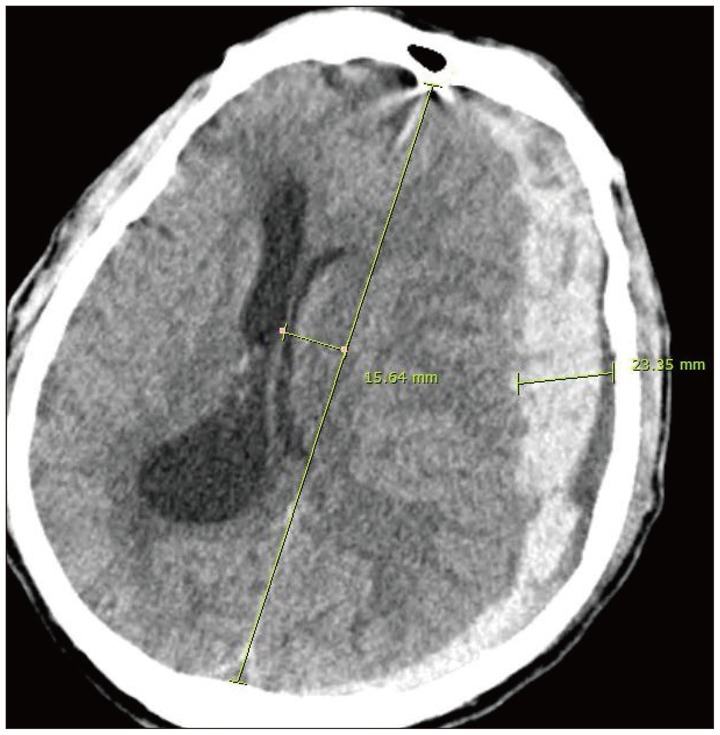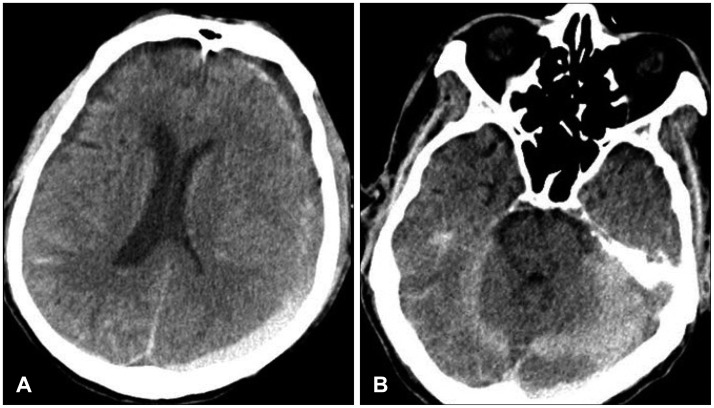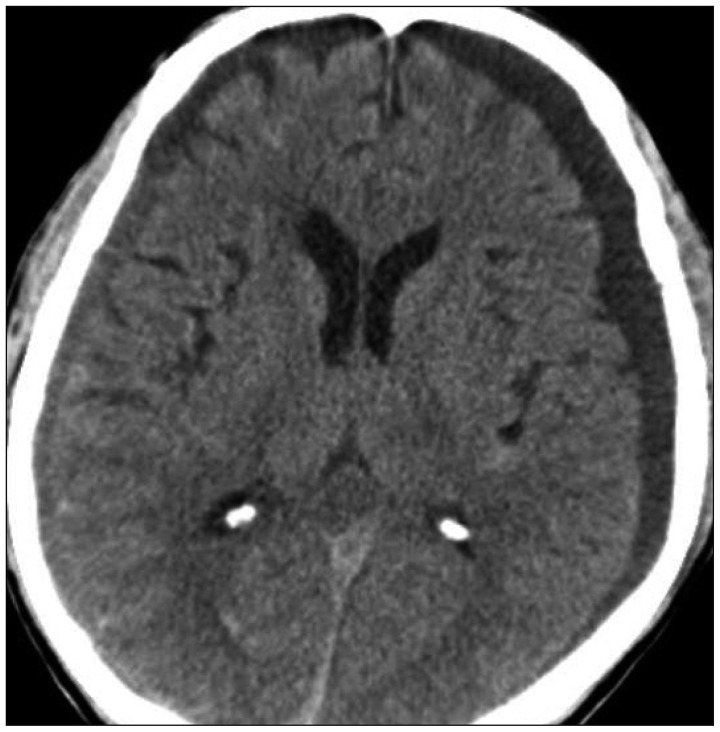Korean J Neurotrauma.
2014 Oct;10(2):134-136. 10.13004/kjnt.2014.10.2.134.
Rapid Spontaneous Resolution of Acute Subdural Hematoma in a Patient with Liver Cirrhosis
- Affiliations
-
- 1Department of Neurosurgery, Uijeongbu St. Mary's Hospital, The Catholic University of Korea College of Medicine, Uijeongbu, Korea. doctorwish@hanmail.net
- KMID: 2256249
- DOI: http://doi.org/10.13004/kjnt.2014.10.2.134
Abstract
- Acute subdural hematoma (ASDH) constitutes one of the most critical emergencies in neurosurgery and rapid spontaneous resolution of ASDH is an infrequent phenomenon. Several mechanisms have been attributed to explain this phenomenon including redistribution of subdural blood, dilution by cerebral spinal fluid and brain atrophy. Rapid resolution of ASDH related to coagulopathy is a rare phenomenon; to our knowledge, only one case has been reported. We report on a patient who showed rapid resolution of ASDH with coagulopathy and also discuss such a rare case with speculation of the coagulopathy as a factor to promote this phenomenon.
MeSH Terms
Figure
Reference
-
1. Ahn ES, Smith ER. Acute clival and spinal subdural hematoma with spontaneous resolution: clinical and radiographic correlation in support of a proposed pathophysiological mechanism. Case report. J Neurosurg. 2005; 103(2):Suppl. 175–179. PMID: 16370287.2. Berker M, Gulsen S, Ozcan OE. Ultra rapid spontaneous resolution of acute posttraumatic subdural hematomas in patient with temporal linear fracture. Acta Neurochir (Wien). 2003; 145:715–717. discussion 717. PMID: 14520555.
Article3. Bortolotti C, Wang H, Fraser K, Lanzino G. Subacute spinal subdural hematoma after spontaneous resolution of cranial subdural hematoma: causal relationship or coincidence? Case report. J Neurosurg. 2004; 100(4):Suppl Spine. 372–374. PMID: 15070147.4. Chaudhary N, Krivosheya D, Small E, Hsia C, Ng W, Leung A. Rapid resolution of acute subdural hematoma in a coagulopathic patient. Can J Neurol Sci. 2013; 40:599–600. PMID: 23786748.
Article5. Kapsalaki EZ, Machinis TG, Robinson JS 3rd, Newman B, Grigorian AA, Fountas KN. Spontaneous resolution of acute cranial subdural hematomas. Clin Neurol Neurosurg. 2007; 109:287–291. PMID: 17182174.
Article6. Kato N, Tsunoda T, Matsumura A, Yanaka K, Nose T. Rapid spontaneous resolution of acute subdural hematoma occurs by redistribution--two case reports. Neurol Med Chir (Tokyo). 2001; 41:140–143. PMID: 11372558.7. Mirzai H, Yaldiz C, Eminoglu M, Orguc S. Neurological Picture. Ultra fast resolution of acute post-traumatic subdural haematoma. J Neurol Neurosurg Psychiatry. 2005; 76:1738. PMID: 16291908.8. Shin DW, Choi CY, Lee CH. Spontaneously rapid resolution of acute subdural hemorrhage with severe midline shift. J Korean Neurosurg Soc. 2013; 54:431–433. PMID: 24379953.
Article9. Tsui EY, Fai Ma K, Cheung YK, Chan JH, Yuen MK. Rapid spontaneous resolution and redistribution of acute subdural hematoma in a patient with chronic alcoholism: a case report. Eur J Radiol. 2000; 36:53–57. PMID: 10996759.
Article10. Watanabe A, Omata T, Kinouchi H. Rapid reduction of acute subdural hematoma and redistribution of hematoma: case report. Neurol Med Chir (Tokyo). 2010; 50:924–927. PMID: 21030807.
- Full Text Links
- Actions
-
Cited
- CITED
-
- Close
- Share
- Similar articles
-
- Spontaneously Rapid Resolution of Acute Subdural Hemorrhage with Severe Midline Shift
- Rapid Spontaneous Resolution of Acute Subdural Hematoma
- Rapid Spontaneous Resolution of Traumatic Acute Subdural Hematoma
- Rapid spontaneous resolution of an acute subdural hematoma: case report
- Rapid Spontaneous Resolution of Contralateral Acute Subdural Hemorrhage Caused by Overdrainage of Chronic Subdural Hemorrhage




